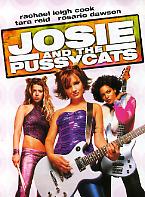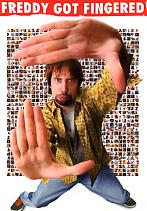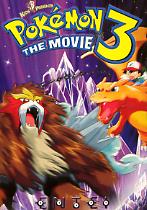| SteveMandich.com | Blog | Bio | Evel Incarnate | Back to Other Stuff | Contact |

Josie & the Pussycats
What's new, Pussycats?
Josie and the Pussycats is the big-screen, live-action adaptation of Hanna Barbera's Saturday morning cartoon, which originally aired on CBS between 1970 and 1974, itself an adaptation of the Archie Comics title that debuted in 1963. The movie remains fairly faithful to both sources: Josie, Val and Melody are the Pussycats, an all-girl rock band hailing from Riverdale, USA, who wear feline ears and tails as part their stage costumes.
In this celluloid version, Rachael Leigh Cook plays redhead Josie, the band's lead singer and guitarist. While she listens to the Ramones and Black Flag (or at least wears their T-shirts), she comes across more like Jewel than Joan Jett. Val, the street-smart bassist, is played by Rosario Dawson, and Tara Reid is cast as Melody, the blonde, terminally moronic drummer. Together, the girls are just another garage band dreaming of superstardom, paying their dues by traveling between bowling alley gigs in a battered van.
The trio is managed by the bumbling Alexander Cabot III (Paulo Costanzo), whose troublemaking sister, Alexandra Cabot (Missy Pyle), has designs on struggling folksinger Alan M. Mayberry (Gabriel Mann), the object of Josie's affections. Pyle's performance is easily the truest to the cartoon, unfortunately, her screen time is minimal. There's little to account for her presence beyond a self-referential gag: "I'm here because I was in the comic book."
After being "discovered" by MegaRecords talent scout weasel Wyatt Frame (Alan Cumming), the 'Cats are signed on the spot, sound unheard. They're flown to "the big city," and within an absurdly brief span of one week, they have Billboard's number one single, "Pretend to be Nice." Videos, photo shoots, magazine covers and the adoration of millions of teenagers ensue.
As it turns out, MegaRecords, controlled by the maniacal Fiona (Parker Posey), is conspiring with the government to use pop music to brainwash the youth of America. The evil scheme centers around a machine called the "Megasound 8000," which laces subliminal commercial messages into the music, thus manipulating teens into becoming mindless consumers.
However, it's hard to imagine that MegaRecords could possibly cram any more ads onto a CD than Universal dropped into this picture, which probably set a new record for product placement in the first reel alone. Dozens of products and corporate logos are prominently displayed throughout: Ford, Chips Ahoy, Starbucks, Planter's Peanuts, AOL, Foot Locker, McDonald's, Target, Kodak, Ivory, Puma, Coca-Cola, Evian, Motorola, TJ Maxx... Are there any scenes which don't show at least one recognizable brand?
Apparently, the point is to skewer our consumer-driven culture with both a ridiculous amount of ads and a knowing wink. Though the running joke is presumably intended to appear subversive, it's still blatant advertising, plain and simple. It's also downright annoying.
Josie also falls short in doing justice to its cartoon counterpart. Gone are the Pussycats' matching leopard-print outfits, and Alexandra's pet kitty Sebastian is MIA. Melody's ears don't wiggle, as they did on TV whenever her sixth sense detected trouble. Nor does the movie address the years 1972 to 1974, when the cartoon became Josie and the Pussycats in Outer Space; perhaps this idea is being held for a sequel.
The band itself, described at one point as "Christina Aguilera times three," lacks any real rock 'n' roll edge. A prime opportunity was blown to depict a group that looks like Sleater-Kinney, sounds like the Donnas, and is as endearing as the Powerpuff Girls. If nothing else, at least they could've gotten the Josie cartoon's theme song right, a bubblegum classic. The tune is indeed covered for the picture, sung by the gal from Letters to Cleo, but it's only heard as the end credits roll. Worse, it's mostly drowned out by a lame blooper reel showing the actors muff their lines.
Filmed in Vancouver, Josie is rated PG-13, for no apparent reason other than the inevitable double-entendre involving the band's name. It fails as a true "rock movie" in the vein of The Girl Can't Help It, A Hard Day's Night, or even Spice World. With no sex, drugs, booze or wild parties (à la American Pie), it doesn't quite classify as a teenage romp, either. A comedy? C'mon.
More than anything, it just seems like a long string of commercials. Sure, its Saturday-morning inspiration existed only to sell toys and cereal during the breaks, but this flick takes crass commercialism to 21st century extremes. The Pussycats can rage against the machine all they want, but really, they're mere shills.
See you at the mall.
Originally appeared in The Daily of the University of Washington
Freddy Got Fingered
Freddy Got Fingered marks the directorial debut of MTV's resident prankster Tom Green, who also co-wrote and stars in the film. For the unfamiliar, Green's schtick involves obnoxious behavior that alternates between the idiotic and the disgusting, including lots of nonsensical babbling, screaming, and his falsetto singing of silly, made-up songs. He also skateboards, as evidenced in Freddy's opening scene, as he shreds through a shopping mall to the sounds of the Sex Pistols' "Problems." If only his acting were anywhere near as proficient.
The 29-year-old Green plays 28-year-old Gord Brody, who still lives in his parents' basement in Portland (which looks suspiciously like Vancouver). Gord draws X-ray Cat, a crime-fighting comic-book feline he hopes to turn into an animated TV series. He follows that dream to Hollywood, where it is promptly squashed by big-shot producer Dave Davidson (Anthony Michael Hall). However, Davidson offers some constructive criticism: "If you really want to be an animator, get inside the animals." Gord takes the advice literally. On his drive back to Portland, he happens upon a dead elk on the highway. He promptly disembowels the beast and then writhes around in its entrails.
The Ramones' facetious "We're a Happy Family" is heard as the rejected Gord pulls back into his parents' driveway, setting the flimsy plot in motion: Gord's hard-working, blue-collar father, Jim Brody (Rip Torn), wants him to get a "real" job and move back out, but Gord stubbornly clings to his cartooning dreams. The two butt heads and repeatedly exact revenge on one another, escalating in both mean-spiritedness and absurdity. (Gord's fragile mother Julie, played by Julie Hagerty, stands idly by.) At one point, Gord falsely tells a family therapist that his father molested Gord's 25-year-old brother Freddy (Eddie Kaye Thomas), hence the film's provocative title.
All of which only serves to set up one gross-out scene after another. Among other incendiary acts, Gord gives a horse a handjob, sucks a cow's teat, sticks his face in the toilet, wears raw steaks as earrings, tongues a gaping wound on his friend's knee, and chews through a human umbilicus, which he later duct-tapes to his own belly ("it's just for fun"). With a tendency toward bestiality, Green seems willing to do anything for a cheap laugh.
Which is probably fine, except when he subjects other characters to his perversions. Gord's love interest Betty (Marisa Coughlan), who aspires to build herself a rocket-powered wheelchair, gets turned on when Gord smashes her paralyzed legs with a bamboo stick. Worse, in a running joke, a little boy gets whacked by a car door, has a bottle smashed across his face, his teeth get knocked out by a baseball, and finally, he's done in by a spinning airplane propeller.
None of this is offensive so much as it is just plain stupid. Green is better suited for his TV show's improvised weirdness, eliciting genuine, candid reactions from perplexed bystanders. Still, any movie whose soundtrack includes the New York Dolls' "Personality Crisis" and "I Gotta Be Me" (performed by both Sammy Davis, Jr. and Iggy Pop) can't be all bad.
Originally appeared in The Daily of the University of Washington, May 3, 2001.
Pokémon 3: The Movie
Gotta catch 'em all! Gotta catch 'em all!
So says the insistent slogan of the enormously popular Pokémon craze. However, Pokémon 3: The Movie isn't quite the feature-length, animated commercial one might expect, what with all the franchise's officially licensed merchandise -- toys, comic books, posters, trading cards, lunch boxes, caps, T-shirts, and, of course, the enormously popular video game from which the whole juggernaut sprung -- though it does resemble little more than a bigger, longer episode of its television cartoon counterpart.
"Pokémania" began in Japan five years ago, when Nintendo's "Pocket Monsters" Game Boy cartridges began flying off toy store shelves. The interactive role-playing game requires contestants to collect a stable of various mutant creatures (which can shrink to fit in owners' pockets), train them in fighting techniques, and then engage them in battles against other players' creatures. The ultimate goal is to become "The World's Greatest Pokémon Master." The game caught fire and spun off the marketing onslaught, along with an afterschool TV cartoon series, home videos, soundtrack albums, and even a Broadway-style musical, Pokémon Live!.
And, yes, the movies. P3 is the series' third installment in as many years, though for many pre-teen fans, the timespan marks a significant chunk of their young lives. Naturally, the film's meandering plot involves much of the aforementioned battles, which, despite a few pithy comments about the value of teamwork and friendship, come across as sanitized, G-rated cockfighting.
Between the battle scenes is a fantasy story about a little girl who loses both her parents, but with the help of the mysterious Unown, a mindreading Pokémon creature that takes the form of swirling alphabet letters, she creates a sort of alternate reality spun from her own imagination. Thus, a leonine Pokémon named Entei becomes her surrogate father, and her home city is turned into a massive, crystalline lotus. Fair enough, but just not as entertaining as watching a sheep-like monster go head-to-head with a fruit bat.
None of this is likely to make much sense to non-fans (it's not even clear on which planet the action is supposed to take place), but that's beside the point -- the kiddies want the monsters. A menagerie of old and new Pokémon make appearances, each one its own unique mutant species and bearing its own bastardized name, such as Squirtle, Smeargle, Jigglypuff, Totodile, Bulbasaur, Cyndaquil, Psyduck, and Furret. In addition, each has its own special strengths and powers, for instance, the most well-known Pokémon, Pikachu (a yellow, pudgy, rabbit-like creature), has the ability to shoot lightning bolts out of his face. The Pokémon universe consists of 250 (and counting) such creatures, providing myriad tie-in merchandise for young collectors, who are constantly reminded that they "gotta catch 'em all!"
Originally Japanese productions, the Pokémon movies are edited and overdubbed for American audiences. The animation, drawn in the classic wide-eyed style of anime, doesn't break any new artistic ground, although it does offer some colorful, swirling, computer-generated effects, which are quickly offset by scenes rendered in the relatively crude style of the TV cartoon, giving the film's overall look a jarring inconsistency.
But the movie isn't intended for connoisseurs of anime anyway, just rabid Pokémon fans. Almost every adult who attended a recent Sunday morning screening was accompanied by at least one child. Amazingly, the kids remained calm and attentive throughout, unlike other family movie screenings in which youngsters often chatter, wail, and run up and down the aisles. A young three-year old friend of mine, attending his first theatrical movie, remained transfixed during the entire show. (Meanwhile, a 27-year-old companion nodded off after about a half-hour.) A smattering of applause rose as the picture ended, the same way a classroom full of second-graders might politely applaud a filmstrip about squirrels.
As a bonus, the animated short Pikachu and Pichu was shown before the main attraction, (presumably to beef up the overall running time to 93 minutes), which amounted to about 20 minutes' worth of slapstick about some monsters running amok in the big city.
According to Pokémon 3's press materials, the Pokémon fad ranked as the largest "child-driven phenomenon" of the 1990s. While such a claim is debatable, Pokémon will likely go the way of Dungeons and Dragons, Cabbage Patch Dolls, Teenage Mutant Ninja Turtles, Beanie Babies, Furby and the rest. In the meantime, the brains behind Pokémon will no doubt continue to repeatedly strike while the iron remains hot, or even lukewarm.
Catch 'em all, if you must.
Originally appeared in Northwest Asian Weekly, April 7-13, 2001.
|
|
© 2004-2011 Steve Mandich |

